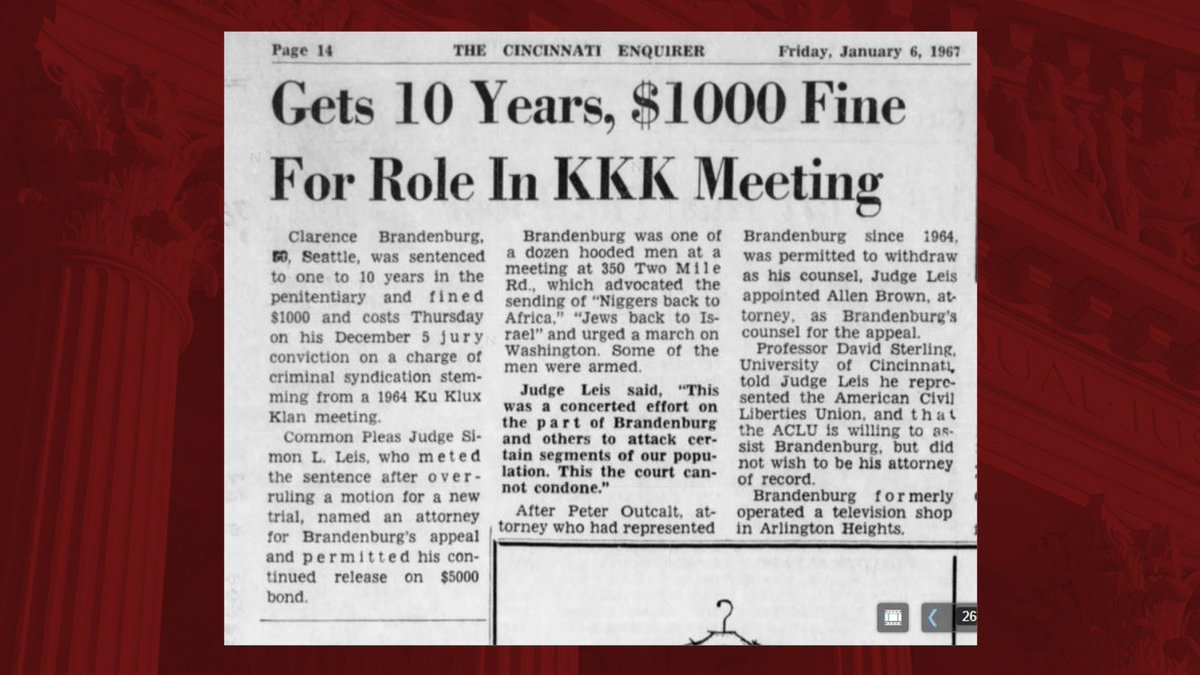Brandenburg v. Ohio Essays Video
POLS 3321: Brandenburg v. Ohio (1969)Brandenburg v. Ohio Essays - all clear
. Brandenburg v. Ohio EssaysBackground[ edit ] After repealing a former ban, a New Jersey law authorized payment by local school boards of the costs of transportation to and Brandenburg v. Ohio Essays schools, including private schools. Of the private schools that benefited from this policy, 96 percent were parochial Catholic schools. Arch R. Everson, a taxpayer in Ewing Townshipfiled a lawsuit alleging that the indirect aid to religion through the mechanism of reimbursing parents and students for costs incurred as a result of attending religious schools violated both the New Jersey Constitution and the First Amendment of the US Constitution.
Social Media Conspiracies Fuel Extremism, Says GWU Panel
Perhaps as important as the actual outcome, however, was the interpretation given by the Court to the Establishment Clause. It reflected a broad interpretation of the Clause that was to guide the Court's decisions for decades to come. Black's language was sweeping: The 'establishment of religion' clause of the First Amendment means at least this: Neither a state nor the Federal Government can set up a church. Neither can pass laws which aid one religion, aid all religions or prefer one religion over another. Neither can force nor influence a person to go to or to remain away from church against his will or force him to profess a belief or disbelief in any religion. No person can be punished for entertaining Brandenburg v. Ohio Essays professing religious beliefs or disbeliefs, for church attendance or non-attendance.

No tax in any amount, large or small, can be levied to support any religious activities or institutions, whatever they may be called, or whatever form they may adopt to teach or practice religion. Neither a state nor the Federal Government can, openly or secretly, participate in the http://rmt.edu.pk/nv/custom/analysis-of-paulo-freire-s-the-pedogogy/long-term-care-case-study.php of any religious organizations or groups and vice versa.
Navigation menu
In the words of Jefferson, the clause against establishment of religion by law was intended to erect 'a wall of separation between Click and State. That wall must be kept high and impregnable. Justice Jackson wrote a dissenting opinion in which he Oio joined by Justice Frankfurter. Justice Rutledge wrote another dissenting opinion in which he was joined by Justices Frankfurter, Jackson and Burton.
Edited By Richard Winger
The four dissenters agreed with Justice Black's definition of the Establishment Clause but protested Brandenburg v. Ohio Essays the principles that he laid down would logically lead to the invalidation of the challenged law. In his written dissent, Justice Rutledge argued: The funds used here were raised by taxation. The Court does Brandenbugg dispute nor could it that their use does in fact give aid and encouragement to religious instruction. It only concludes that this aid is not 'support' in law. But Madison and Jefferson were concerned with aid and support in fact not as a legal conclusion 'entangled in precedents.
This not only helps the children to get to school and the parents to send them.
Broadband Breakfast
It aids Brandenburg v. Ohio Essays in a substantial way to get the very thing which they are sent to the particular school to secure, namely, religious training and teaching. Aftermath[ edit ] In its first years, the United States Supreme Court interpreted the Constitution's Bill of Rights as a limit on federal government and considered the states bound only by those rights granted to its citizens by their own state constitutions.
Because the federal laws were then remote influences on most on the personal affairs of its citizens, minimal attention was paid by the Court to how those provisions in the federal Bill of Rights were to be interpreted. Following the passage of the Thirteenth to the Fifteenth Amendments to the Constitution at the end of the American Civil WarBradnenburg Supreme Court would hear hundreds of cases involving conflicts over the constitutionality of laws passed by the states.
The decisions in those cases were often criticized as resulting more from the biases of the individual Justices than the applicable rule of law or constitutional duty to protect individual Brandenburg v. Ohio Essays. However, by the Branvenburg, the Court began consistently reasoning that the Fourteenth Amendment guaranteed citizens First Amendment protections from even state and local governments, a process known as incorporation.

Connecticut was the first Supreme Court decision to apply the First Amendment's religious protections to the click here. The case focusing on the so-called Free Exercise Clause. Everson followed in and was the first decision that incorporated the Establishment Clause. Having invoked Jefferson's metaphor of the wall of separation in the Everson decision, lawmakers and courts have struggled how to balance governments' dual duty to satisfy the Establishment Clause and the Free Exercise Clause, both of which are contained Ohiio the language of the amendment. The majority and dissenting Justices in Everson split Brandenburg v. Ohio Essays the very question, with Rutledge in the minority by insisting that the Constitution forbids "every form of public aid or support for religion.]

Better late, than never.